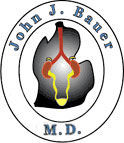
www.flinturology.com
Urology Services, Inc.
G-1121 West Hill Rd.
Flint, Michigan 48507
Tel: 810.232.8888
Fax: 810.232.9190
Email: jbauer@flinturology.com
[map]
 |
John J. Bauer, M.D.
www.flinturology.com Urology Services, Inc.
|
Myofascial syndrome is a term used to describe the type of pain some men experience in their testicles, groin and prostate. Prior to this diagnosis, a thorough history, physical exam, urine tests, and occasionally, radiology tests are performed.
First, a quick anatomy lesson: sperm are made in the testicles. They then travel trough the spermatic cord and into the prostate and urethra where they are emitted during ejaculation. The spermatic cord is attached to the testicle. It runs though the groin and inguinal canal, then down to the deep pelvis where the prostate is located. Around the entire cord is a layer of muscle, called the cremasteric muscle and its fibers. The prostate also is composed of muscles and gland-forming cells.
After an injury or infection, the organs in this area become inflamed, which can cause pain. This pain can radiate anywhere along the spermatic cord, depending on the intensity of the inflammation. Often, the inflammation persists and recurs even though the original injury or infection has passed. Because all the muscles and fibers are connected, inflammation originating in the testicle can cause pain to radiate all the way up the cord and to the prostate and penis. It is not uncommon to have impotence associated with flare-ups of this condition.
Treatment for these symptoms consists of the following:
While the treatment is usually effective, it is common to have occasional flare-ups that can be caused by a variety of factors. When this occurs, a repeat treatment course is often prescribed. Ongoing testing is performed to ensure that other possible problems, such as prostate cancer, are not missed. There is no known relationship between prostatitis and prostate cancer.